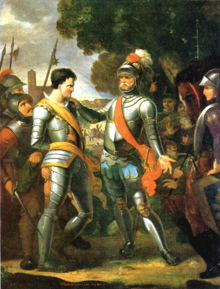Tjarko Meyer Cramer
Tjarko Meyer (Lucas) Cramer (born June 1, 1780 in Manslagt , † April 26, 1812 in Rome ) was a German painter . He was best known for his painting of the capture of Ocko tom Broks by Focko Ukena in 1427. The greater part of his work is considered lost.

Life
Tjarko Meyer (Lucas) Cramer was born on June 1, 1780 as the eldest son Cramer of the teacher Albert Dircks Cramer and a daughter of the Manslagter preacher Tjarko Meyer. He had four brothers, two of whom also painted and of whom paintings and drawings have been preserved.
Soon after his birth, the family must have moved to Emden, where Tjarko grew up. There the local painter Peter Anton Honsberg taught him the basics of painting. He evidently implemented this so successfully that a group of art-loving family friends financed him the necessary lessons at the Royal Danish Academy of Art in Copenhagen. He probably enrolled there in the spring of 1800 and studied for the following eighteen months. His thesis was a self-portrait, for which he received the academy's small silver medal on October 5, 1801.
He then returned to Emden for a short time before he spent almost a year in Berlin and finally moved to Dresden in autumn 1803. There he worked as a copyist in the Old Masters Picture Gallery . He improved his livelihood with copies of Italian masters and Rubens paintings, which he sold in Emden. This made him known in East Frisia, where he received his most important commission in 1803: The East Frisian Landscape commissioned him to make a painting of Ocko tom Brok's capture after the battle in the wild fields in 1427 and paid him the impressive sum of 400 guilders for it .
Nevertheless, Cramer did not stay in East Frisia. In 1804 he first traveled to Switzerland and from there through Italy to Rome, where he associated with Caroline and Wilhelm von Humboldt and the Danish sculptor Bertel Thorvaldsen , among others . In Rome, too, he carried out orders from East Frisia, such as a depiction of the resurrection, which was a large altarpiece in the Catholic Church in Emden until the fire in 1943.
In the late summer of 1808, Cramer left Rome and learned in Switzerland that the newly founded Koninklijke Academie van Beeldende Kunsten had accepted him as a scholarship holder. The scholarship also included a two-year stay in Rome, which is why he immediately returned to Rome. A year later, Cramer fell seriously ill. This had an impact on his work, so that he could no longer meet the conditions of the Dutch Academy. In March 1811, his scholarship was canceled. In early summer he made his last trip to Naples. After returning to Rome, his condition worsened. He soon became bedridden. During this time he converted to the Catholic Church, was baptized, took the name Lukas, and four days later he started working. His health continued to deteriorate before finally succumbing to the disease on April 26, 1812. Two days later he was buried in the church of Sant'Andrea della Fratte .
Preserved works
- Count Gerd von Oldenburg near Cirk von Friedeburg . 1802 (owned by the Ostfriesisches Landesmuseum Emden )
- Ocko tom Brock is captured in front of Focko Ukena after his defeat in the Battle of the Wild Fields (1427) . 1803 (owned by the East Frisian landscape of Aurich)
- Portrait of Conrad Barinck (Pastor of the Mennonite Congregation Amsterdam) . 1803 (owned by the Mennonite Congregation Amsterdam)
- Portrait of Wilhelm Krull (Reformed preacher of the Emden community). 1803 (owned by the Reformed Church in Emden).
Copies received
- Christ's head (after Annibale Caracci) (owned by the East Frisian State Museum Emden)
- The Drunken Silenus (after Rubens Bacchantenzug ) (In the possession of the Ostfriesisches Landesmuseum Emden)
- Three naked boys surrounded by apples, plums and grapes (based on Rubens ' excerpt from Rubens' Bacchantes ) (In the possession of the Ostfriesisches Landesmuseum Emden)
Web links
- Digital copies of several letters from to Tjarko Meyer Cramer in the archive of the Thorvaldsen Museum
literature
- Erich von Reeken: Famous Butenostfriesen. Short life reports, compiled and edited by Erich von Reeken . Empty. 1984. pp. 66-68
Individual evidence
- ↑ a b c d e Sabine Heissler: Tjarko Meyer (Lukas) Cramer. In: Biographical Lexicon for East Frisia. Martin Tielke, 2001, accessed February 14, 2020 .
- ^ A b Arends, Friedrich .: Earth description of the principality of East Friesland and the Harlingerland . Schuster, Leer 1972, ISBN 3-7963-0025-1 , p. 75 .
| personal data | |
|---|---|
| SURNAME | Cramer, Tjarko Meyer |
| ALTERNATIVE NAMES | Cramer, Tjarko Meyer Lucas |
| BRIEF DESCRIPTION | German painter |
| DATE OF BIRTH | June 1, 1780 |
| PLACE OF BIRTH | Manslagt |
| DATE OF DEATH | April 26, 1812 |
| Place of death | Rome |